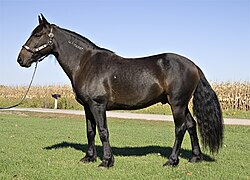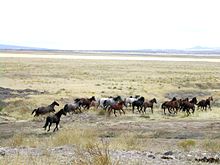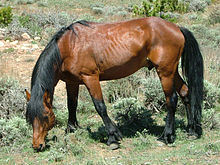Mustang (horse)
| Mustang (horse) | |
|---|---|

|
|
| Important data | |
| Origin: | North America |
| Main breeding area: | Feral horses; no targeted breeding |
| Distribution: | North America |
| Stick measure : | inconsistent approx. 140 - 150 cm |
| Colors : | all colors and drawings |
| Main application area: | |
Mustangs are horses that live in the wild in North America . Mustangs are not wild horses , but the descendants of various European domestic horse breeds . They were introduced to the New World by the Spanish conquistadors in the 16th century (mostly Arabs and Berbers, as well as other domestic horse breeds used in Spain at the time). Many of these animals escaped ( captive refugees ), spread over large parts of North America by the end of the 18th century (→ expansion map in the article “Prairie Indians” ) , feral and established a stable population as neozoa ( biological invasion ).
Mustangs are small, tough, compact horses cm 140-150 Height reach. They are very frugal and have a stubborn and independent character. Their exterior (appearance) includes hard and small hooves, a stable foundation, rams head , a low neck, little withers and a strong back with sloping croup .
Word origin
The origin of the term mustang is not clearly understood. There are several sources that state that the term comes from the old Spanish mesteño , a name for the property of the Spanish herders, the mesta . The etymological research introduces the concept of the Spanish word Mestengo back (stranger or vagabond) controlled by mostrenco derived. As mostrenco a stray publicly paraded sheep is called, which finds in this way its owner.
Meaning of the mustangs among the Indians
The Indians learned the Mustangs through the encounter with the conquistadors first as sacred animals to worship, where they met with awe and respect. But the mustangs served the Indians primarily as a source of meat if they could somehow steal the animals from the settlers. It was not until the 17th century that the Indians themselves learned how to handle animals and used them for hunting, war, breeding and as a means of transport. The Plains Indians used special carrying frames, known as travois , to transport their tipis , which the animals could easily pull. This testifies to their great toughness and, despite the wilderness, very human - related species. These Plains Indians , who were able to make contact with the horses early on, include the Comanche and Apaches , who were known to be very good riders. Probably the best-known Indian horse breeding goes back to the Nez Percé Indians, who proceeded selectively when choosing their animals, from which today's Appaloosa breed emerged. However, this breed only became known after this strain was abducted to the Northern Idaho reservation in Idaho around 1877 after a war .
Importance of the Mustangs for the development of the USA
The cowboys often used mustangs as riding horses. The colonization of the west also took place thanks to the Mustangs. Unridden Mustangs were known as Broncos . The term comes from Spanish and means wild, young horse. Riding in wild mustangs was pretty dangerous. Often times, the cowboys used violence against the Broncos to break their will. As part of the founding myth of the United States, three mustangs are depicted on the state quarters of Nevada.
The fight of daring cowboys with wild mustangs became a myth and found its way into the US from 1900 with the rodeo disciplines bareback riding (riding broncos without a saddle), saddle bronc riding (riding broncos with a saddle) and wild horse race (catching wild horses) american popular culture. In the context of rodeo, bronco does not mean that the horse is not ridden, but that it is a specialist in the most athletic leap jumps possible.
Inventory maintenance

Over half of all North American mustangs live in Nevada . Significant populations are in Montana , Wyoming, and Oregon .
By 1900 the number of Mustangs had increased to over two million, so that they represented competition for the keepers of farm animals . They were then hunted for meat. When motor vehicle and helicopter hunting emerged, their numbers rapidly declined.
In 1959, the Mustangs were placed under protection and motorized hunting was banned on state land. Nevertheless, stocks continued to decline.
Since 1971, the Mustangs population has been controlled by the Bureau of Land Management (BLM).
In 1973 a horse adoption program for captured mustangs was started. One method of catching the horses is to use a tame bait or juda horse , which allows a herd of mustangs to be driven into a gate by a helicopter . The bait horse leads into the gate and because of the herd instinct the others follow it. To protect it, the Juda horse is the first to be released. The aim is to reduce the population through relocation to another territory . Before that, the Mustang populations were reduced by slaughter .
The BLM considers 26,000 Mustangs to be a reasonable inventory. However, in February 2010, the wild population was 33,700 horses and 4,700 wild donkeys called burros. Another 34,000 captured Mustangs are on the fenced-in land of the BLM. Whenever the number of Mustangs living in the wild is significantly higher than what the BLM considers appropriate, Mustangs are captured. There are far more mustangs captured than there are prospects for adoption. The stocks of captured horses on BLM land are threatening to increase. Since the myth of the mustang is sacrosanct in America, the surplus animals cannot simply be slaughtered these days ; instead, various efforts have been made to reduce the number of horses captured.
- In 2010, the BLM publicly proposed that the horses be euthanized , but this affects the quality of the meat.
- In 2009, US Secretary of the Interior Ken Salazar proposed the creation of state wild horse reserves in the Midwest to house sterile animals.
- In January 2005, a controversial bill by Republican MP Conrad Burns was passed by Congress allowing the BLM to sell captured Mustangs that are over 10 years old and unable to adopt, typically only to slaughterhouses is possible.
- Madeleine Pickens , wife of oil tycoon T. Boone Pickens, made a suggestion to house surplus animals on a private reserve in Northern Nevada .
- There are also increased efforts to find suitable adopters. An example of this is a kind of competition in which horse trainers are given 100 days to tame and ride 100 mustangs, which can then be adopted via an auction.
The BLM sells the horses to be slaughtered for less than $ 100 per horse. In the United States, eating horse meat has become a taboo since 2007, when the last horse slaughterhouses closed . The meat is therefore exported to Europe - especially France - and Japan or sold to Canada for animal feed.
There is a controversial debate as to what number of wild mustangs is appropriate. The BLM manages the US public land and not only has to protect the mustangs, but also grant grazing rights to livestock owners and raw material concessions. According to animal rights activists, this creates a conflict of interest from which the BLM would set the appropriate number of Mustangs too low.
Animal rights activists criticize that there are more trapped mustangs than free-living mustangs on public land. It is expensive to feed the captured mustangs, and there is insufficient demand for captured mustangs, except at slaughterhouses. Therefore, animal rights activists advocate catching fewer Mustangs and letting more Mustangs live in freedom.
attachment
supporting documents
- ↑ http://www.etymonline.com/index.php?term=mustang
- ↑ Who speaks to the horses . (Original English title: The Man Who Listens to Horses; published 1996) - Bergisch Gladbach: Bastei Lübbe, 1997. - ISBN 3-404-60466-0
- ↑ name = "National Summary, FY2007"> National Summary, FY2007 (PDF) Archived from the original on July 22, 2012. Info: The archive link has been inserted automatically and has not yet been checked. Please check the original and archive link according to the instructions and then remove this notice. Retrieved August 9, 2010.
- ↑ https://www.blm.gov/adoptahorse/onlinegallery.php
- ^ French, Brett: Controversial roundup of mustangs begins in Pryor Mountains . In: Billings Gazette . September 3, 2009. Retrieved February 4, 2011.
- ↑ The Limits of Freedom. In: Frankfurter Allgemeine Zeitung , June 28, 2005.
- ↑ Mangum, "The Mustang Dilemma," p.77
- ↑ "Plan to kill wild horses runs into trouble" "Associated Press," July 7, 2008
- ↑ a b Mangum, “The Mustang Dilemma”, p.78
- ^ The Story Behind the Burns Amendment . Wildhorsepreservation.com. Retrieved August 9, 2010.
- ^ Burns amendment . Wildhorsepreservation.com. December 6, 2004. Retrieved August 9, 2010.
- ↑ Archived copy ( memento of the original from October 30, 2011 in the Internet Archive ) Info: The archive link was inserted automatically and has not yet been checked. Please check the original and archive link according to the instructions and then remove this notice. The Extreme Mustang Makeover
- ↑ Is Horse an Acceptable Meat Course? P. Smith, January 2011
- ^ A b Philip Bethge: Expensive Captivity. P. Bethge, Der Spiegel , 2010. A search on “Calico Mountains Region” leads to the section that discusses the number of Mustangs.
swell
- Hans Läng: Cultural history of the Indians of North America . Olten: Walter, 1981
- Judith Draper: The big book of horses and ponies . Bindlach: Gondrom, 2002
- Jürgen Döring: Cultural change among the North American Plains Indians. On the role of the horse among the Comanches and Cheyenne . Berlin: Reimer, 1984
literature
- North American mustangs. In: Westermann's Illustrirte Deutsche Monatshefte Vol. 30,2, No. 82 (July 1871), pp. 392–394 (with an illustration)
- Andrea Pabel; Hauke Kock: Wild mustangs, bold riders: the horses of the Indians . Kosmos, Stuttgart 1997, ISBN 3-440-07460-9 .
- Hans-Heinrich Isenbart: Mustangs: Wild Horses in America . With photos by Jay Featherley. Children's book publisher, Lucerne 1987, ISBN 3-276-00060-1 .
- Peter Clotten: The last Mustang . Photos by Tony Stromberg. Müller-Rüschlikon, Stuttgart 2009
- Wilhelm Bittorf , photos: Nik Wheeler: Horses: No room for mustangs in the Wild West? In: Geo-Magazin. Hamburg 1979, 4, pp. 88-104. Informative experience report: "Every year hundreds of wild horses are caught and given up for adoption by Americans on behalf of the US government." ISSN 0342-8311
Web links
- Bureau of land management USA - Internet adoption program
- The International Museum of the Horse
- Protection and conservation of the American mustang



